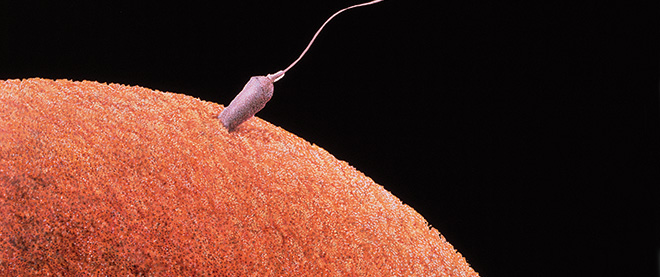Rewinding the biological clock
Stem cells may hold the key to a radical advance in infertility treatment
Francis Leroy / Biocosmos / Science Photo Library
Share

Reproductive biologists have been working for decades to solve one of the great mysteries of human fertility: why do women produce all the eggs they will ever have while still in the womb, only to have most of those eggs die off before birth, and many more before the woman reaches puberty?
Jonathan Tilly, chair of the biology department at Northeastern University in Boston, was among those drawn to studying this enduring puzzle. But what he found instead was evidence of a fundamental flaw in the basic tenets that govern our understanding of the female reproductive system. If successful, his research could open the door to the most radical advancement in infertility treatment since in vitro fertilization was invented nearly 40 years ago.
When Tilly examined the ovaries of mice, he noticed that their eggs were dying much faster than the overall egg count would suggest. The mice appeared to be producing new eggs, and were doing so by a process that no one really understood.
Tilly’s team began researching the role that stem cells play in the process. Chinese researchers later identified a specific type of stem cell located in the ovarian tissue.
Last year, Tilly’s team published evidence that the same process happening in mice was occurring in humans. He isolated human ovarian stem cells and then implanted them into mice to produce an immature egg called an oocyte.
The implications are huge. If a woman continues to produce eggs into adulthood, then menopause doesn’t happen because her body has exhausted its lifetime supply of eggs, but because the process to make new ones has stopped working. It also means that infertility problems in older women aren’t happening because the eggs she is born with have grown too old, but because the body’s quality-control process has broken down so that it is pumping out poor-quality new eggs.
“There’s not a lot you can do about an egg that is 40 years old and has gone bad because of 40 years of accumulated damage,” says Tilly. “But there is something very much one can do if the egg quality really reflects not eggs going stale, but a production pipeline that’s run amiss.”
More importantly, if researchers could find a way to somehow kick-start the ovarian stem cells in older women who had stopped producing viable eggs, they could potentially rewind the biological clock.
“The cells should be present in the ovaries of all women, young and old,” says Evelyn Telfer, a reproductive biologist at the University of Edinburgh, who is working with Tilly to try to create a viable human egg from ovarian stem cells and then fertilize it. “The difference is that in older women, the cells don’t function the same way because of the change in the environment of the actual ovary. But if you can take these cells and work out how to activate them in the environment we’ve already got, the woman’s own ovary, perhaps you can make new eggs.”
Despite garnering international attention, Tilly’s work remains highly controversial among fertility researchers, who point out that others have had trouble replicating his findings.
“He’s a very bright guy, but I think it’s very preliminary,” says Ellen Greenblatt, director of the Mount Sinai Centre for Fertility and Reproductive Health in Toronto. “I don’t think it has any clinical application in the near or distant future.”
The rising number of women who are delaying motherhood is the biggest problem facing infertility researchers, and Greenblatt worries that Tilly’s research could offer false hope to women who are looking for ways to prolong their fertility, or even reverse menopause. “The message people need to hear is that family planning means planning your family, not being on the pill until 40,” she says. “But it’s not a message women want to hear.”
While it remains both medically and ethically controversial, scientists are pressing ahead in exploring the role stem cells play in fertility. Last month, researchers at the University of Kyoto used stem cells derived from the skin of mice to create viable eggs, which were then implanted into mice to produce healthy, fertile pups. The process involved something known as induced pluripotent stem cells—cells that can be coaxed in a lab to transform into any cell in the body, including both sperm and eggs. Since those cells can be taken from the skin of both men and women, they could conceivably allow same-sex couples to one day be able to have children who are genetically related to both parents.
Replicating the process with human stem cells “will take a few years, but is very likely to be possible,” says Harry Moore, director of the Centre for Stem Cell Biology at the University of Sheffield, though it will depend on regulatory approval. “It is rather like the beginning of IVF, when a lot of people were against the idea of ‘playing God,’” he says. “However, once people saw medical value in treating aspects of infertility, objections were far less.”
Overcoming resistance from both regulators and the scientific community remains Tilly’s biggest hurdle in his attempts to find new treatments for infertile women, treatments that remain essentially unchanged since the 1970s. “Even in 2013, in effect what you’re doing is joining an egg and sperm and then keeping your fingers crossed,” he says. It’s taken nearly a decade since he published his first paper questioning the established dogma on female fertility for Tilly’s work to gain traction. “But with all the tools and understanding we now have,” he says, “I think the next 10 years will go much quicker.”